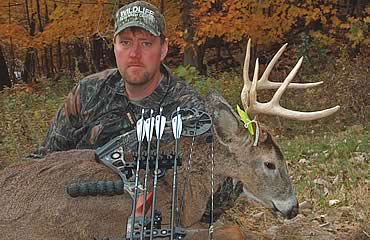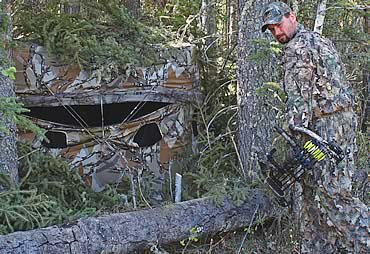Try to remain undetected, even when you don’t see the buck you’re after.
I needed a break. During the off season, I’d invested several weeks in scouting and stand preparation. My intention had been to hunt the property hard. I knew it held mature bucks, and I staked my Wisconsin buck tag on taking one. I was confident that all I needed was to put the time in on the stands I’d prepared to accomplish that mission.
When an unanticipated twist of events occurred, my plans went haywire. Instead of being able to invest weeks into filling my tag, I was suddenly left with a total of one day to hunt the property.
Although several of my stands had already been hunted by others, one had been left alone. Because I viewed it as being as good as, or better than, the others, that was where I decided to stake my chips.
About 30 minutes after first light, things began to happen. The first deer to show up were three does and four fawns. After milling around, never showing an inkling of nervousness, they all bedded within 40 yards and began to chew their cud. Just shy of an hour into the hunt, one by one they stood and slowly meandered off in search of breakfast.
Although I’d yet to see a buck, the activity bolstered my confidence. Despite being more than a month into hunting season, this group was clearly relaxed. I had been correct that the stand covered a doe bedding area, and that it was still fresh. Good things could happen at any moment.
It didn’t take much longer for my optimism to prove well-founded. With the unmistakable sounds of a chase approaching my stand, I grabbed my bow and got into position. Tearing through where the does had been bedded a half-hour before, the adult doe was on a mission to lose her pursuer. With a mature 10-pointer just a few feet behind her, the doe blew through without a chance of stopping her — or him.
A nice 8-pointer followed about 40 yards behind, however. As the newcomer stepped into my shooting lane to sniff the bed of a departed doe, I put my 30-yard pin on its vitals and sent the arrow on its way. A kick and an explosion of energy later, all that was left was following the good blood trail to where the buck expired. The fresh stand had worked.
Freshness Matters
All else being equal, I bet most of you would prefer to climb into a fresh, never-sat-before stand each time out. It’s a given that every hunt has the potential to reduce the odds of the stand producing. If you hear a hunter complain about a guided hunt, it’s probably because the outfitter overhunts his stands.
It only makes sense that a fresh stand has better odds of producing a successful hunt. Mature bucks are hard enough to take when they don’t have a clue that they’re being hunted. Once they know, it gets much tougher. To take it a step farther, if a buck learns he’s being hunted from a particular tree, the odds go ridiculously low.
My experiences tracking deer in northern Wisconsin’s snow-covered woods back up that philosophy. Picking apart buck patterns by following their tracks is a fantastic teacher, but it took me awhile to learn one of most important lessons.
 I noticed that bucks would make large circles around areas for no apparent reason. Once I looked for the right clues, I found that old deer stands were the cause for these seemingly random acts of avoidance. I have no doubt that deer learn the locations of stands and that mature bucks avoid them.
I noticed that bucks would make large circles around areas for no apparent reason. Once I looked for the right clues, I found that old deer stands were the cause for these seemingly random acts of avoidance. I have no doubt that deer learn the locations of stands and that mature bucks avoid them.
Since every trip to a setup can educate deer to your presence, it stands to reason that the first time hunting it is when you need to connect. But there are things you can do to reduce the risk. The key to hunting stands numerous times without experiencing a drop-off in production is to identify the potential tip-offs and minimize them.
Remain Hidden
First and foremost, make sure deer don’t see you. Find the right balance between height and cover to keep from being spotted and to help cover your movement. I’ve found that having quality back cover is the most critical aspect of concealment while in a stand.
When choosing stand height, my primary objective is to find the spot on the tree that covers my backside. With an array of objects behind me, I can get away with a little movement, and my outline is always broken. Front cover is good, but back cover is better. The most convenient outline-breakers are large tree trunks, branches and other nearby trees.
With eyes on the sides of their head, deer have good peripheral vision; the drawback of that trait is that their depth perception is not as strong. Deer have a difficult time picking up individual objects embedded in a tangle of branches.
When provided with quality back cover, I’m comfortable as low as 12 feet. When trees don’t provide cover, I most often climb up to 25 feet or more. Going higher compensates for a lack of cover, but it has its drawbacks, like creating difficult shooting angles.
Don’t be afraid to get creative and make your own cover. Use wire to attach cut branches to the back side of your tree, and put some in the grate of the stand for front cover. Check your state regulations and/or with your landowner to make sure cutting is okay.
Where such cover isn’t allowed, the PMI cover system can be the ticket. This set of flexible branches straps to the tree in front or behind. Once the unit is in place, it can be molded to fill gaps. Just like that, the barest tree has instant cover.
 Beating a Buck’s Nose
Beating a Buck’s Nose
As important as cover is, the number one reason most hunters get pegged is scent. Two precautions will greatly minimize your scent footprint.
While there’s enough material on scent control for another article, the first rule is to commit yourself to being scent-free. Deer don’t care if foreign scent comes from the hunter, a release, a grunt tube or any other object you might bring into the woods. They’ll spook no matter what the scent source. Thoroughly treat every object, including yourself, and it will pay big dividends.
And although you’ve heard it before, play the wind. Also take time to learn about air currents. Air currents (and therefore scent) don’t move in straight lines. Air can flow around obstacles such as hills or a mature grove of pines, and can skip over or fall into valleys, depending on air and ground temperatures. What really helped me was envisioning the wind as a river. How does the water react to a large rock? It goes over and around, swirling at the opposite side.
Now add in thermals, which tend to lift scent in the morning and drop it in the evening, and you begin to get a better picture of how scent flows in the woods.
Getting In and Out Undetected
Getting into and out of your stand without being winded is critical. Although it’s been preached for years, few hunters pay attention to the wind for their approach and departure routes. The biggest reason is that if you’re really going to hunt the wind, you’ll have to pass on many promising stand locations.
To keep your stands fresh, study the habitat and determine which areas you can access and depart from safely. Determine which wind you need to hunt a stand, and then be disciplined enough to hunt stands only when the wind is right. If the wind changes during a sit, it’s time to move.
Speaking of moving, don’t get pegged when climbing out of a stand. Few things booger a stand faster than having deer watch you climb down the tree. In most cases, the best thing to do is simply wait the deer out. Because of their browsing nature, deer tend to keep moving as they slowly feed through a food source. Allow the deer to feed their way farther from your stand, and then quietly slip out.
When waiting isn’t an option, I will snort, bark or even howl like a coyote to clear deer from the area. These actions spook deer, but they’re also natural occurrences and don’t allow the deer to focus on me and my stand. However, if I see a shooter buck, I almost always choose to wait him out.
Another effective method of getting out of your stand is to have someone pick you up. In many areas, deer are exposed to human activity. With the exception of places where road hunting is the norm, deer see farm equipment, trucks and ATV traffic as nothing more than a nuisance. The vehicle will push the deer away from the stand long enough for you to make an exit.
Covering Your Tracks
Unfortunately, even your most safe routes to and from a stand will likely cross deer trails. That creates a high risk of educating deer even after you’ve left the woods. Far more deer learn of our activities after we’re gone than they do while we’re in the woods.
And while most of us wear clean rubber boots, I don’t believe that’s enough.
With each step, we leave a small amount of rubber behind. Whether deer associate that trace odor with hunting doesn’t matter; the result is the same. Scent-Lok gloves are a big help, but it’s important to avoid high-traffic deer areas and to touch as little foliage as possible.
Spray your boots with scent-killer and wear non-estrous urine-laced boot pads. When I do this, I’m not attempting to attract deer. When they plant their noses to the ground to sniff where I’ve stepped, the non-threatening doe urine is the strongest odor they detect. I have yet to see a deer spook from my track when using this method.
I’ve also had success using the Elimitrax product. This over-boot system is constructed of an odor-free material that doesn’t allow scent transfer. Because it also covers the legs, brushing objects from the crotch down isn’t a concern.
Conclusion
Keeping a stand fresh boils down to staying undetected while hunting and not tipping deer off when you go in and out. While it’s impossible to hunt a stand and not leave some trace of your presence, the more you can do to put deer at ease and make them focus on things other than you and your stand, the better. With a little care and planning, you can keep your stands fresh throughout the hunting season.
This article was published in the December 2007 edition of Buckmasters Whitetail Magazine. Join today to have Buckmasters delivered to your home.